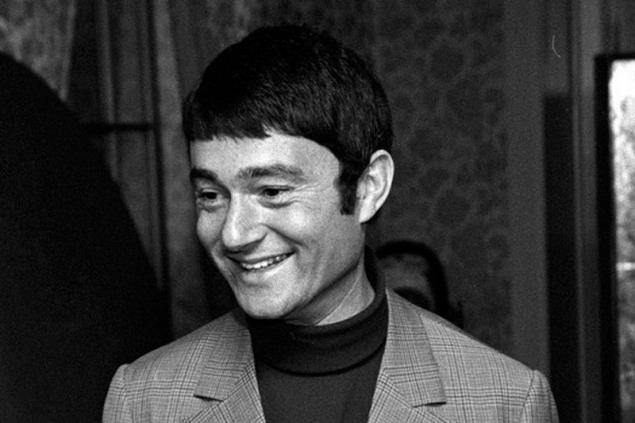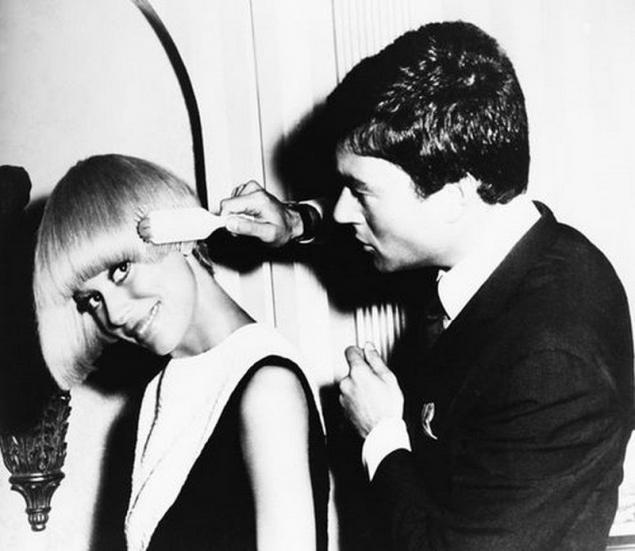146
Why Vidal Sassoon's mom thanks beauty with haircuts
Before the appearance of this man in the world of hairdressing, women’s hairstyles looked completely different. Those crazy haircuts! Naches with a ton of varnish, which spent more than one hour in the salon. Not a hairstyle, but a monolith that is not subject to any element. What women did not go for their perfect hairstyle! And they slept almost standing, and their head was scratched with a spoke, because their fingers did not squeeze through the varnish, and they sat in the salons for hours. That was until he came along...

Editorial "Site" He's going to tell you how a simple guy from a poor family revolutionized the fashion world by changing women's lives.
The most famous hairdresser of the twentieth century was born in a poor family. The boy’s childhood was quite difficult. First, my father left the family, after several years of wandering around shelters. After 7 years in a Spanish-Portuguese-Jewish orphanage, the boy was able to return home. His mother got married again and life was getting better.
In 1942, when there was a war around and London was under constant bombardment, a story occurred that became the starting point in Vidal’s career. Shorting long hours in bomb shelters, the boy indulged in dreams. He imagined that he would become a footballer and be rich, successful and famous. He shared his dreams with his mother, to which she replied that she always saw him as a hairdresser, because it is a constant piece of bread. Then she dragged him to Adolph Cohen's salon in the East End.

The cost of education was unaffordable for Vidal’s mother, but then an incredible story happened. Vidal later recalled, We headed for the door. I was happy. Taking off my hat, I opened the door in front of my mother with a gallant gesture, which I watched in a movie, and we went out.
There were footsteps behind me. Catching up with us, Cohen said to me, ‘I see you, young man, have great manners. Leave on Monday without any charge.” My mother’s face shone, and my smile immediately came off. I cursed myself and that movie with that stupid gallant gesture.

The young man did not like the training terribly, he was bored with boredom. He abandoned this business and rushed to find new jobs. Active social activities, then dreams of the architectural - the usual youth search for themselves. What else do you do when you're 20? It all ended when his stepfather died and his mother asked Vidal to come home.
It must have been fate. In London, he again gets a job in the barbershop, but this time the work really inspires and delights him. He was very lucky, he got into the salon of the famous London hairdresser Raymond Besson, who quickly made Sassoon famous. A few years later, Vidal opens his salon, and queues of customers are already to him.

It takes off in the '60s. A time of change, when men increasingly went without hats, and women - in skirts of indecent length. But still with strange hairstyles, which took a lot of time to lay. He recalls, “Women of my time spent half their lives in salons, and I thought, ‘Why don’t they just cut their hair once a month so that their hair takes shape?’” And Sassoon made it a reality by giving it to the world. Short asymmetrical haircuts.
He made his debut with a haircut that transformed the queen of miniskirts, the famous designer Mary Quant. Vidal thought for a long time what kind of hairstyle could fit into a miniskirt, and realized that such simply does not exist. It was then that he came up with a haircut, for which millions of women were grateful to him. In fact, not even one, but a whole collection of hairstyles that can be laid without a hairdresser. This revolutionized the world of hairdressing.

His bold haircuts are a rude slap in the face of fashion and public taste of the time. Just as Coco Chanel freed women from corsets, Vidal freed them from the heavy lacquered construction called hairstyle. Out of the curlers, varnishes, hair styling forceps. A good haircut and strengthening shampoo are all that a woman needs.
A new ideology blew up the industry, customers, including celebrities, rushed to the master. At the height of fame Sassoon was when Vogue published a photo of actress Nancy Kwan, which he cut a lush hair. Experimenting, Sassoon proposed new geometric shapes. The fruits of his creations received the names of their first owners: Mia Farrow (haircut under an elf), Carol Channing and Peggy Moffitt (beans), Grace Coddington (aka Five Dots).

But the main feature of the master was the so-called salon memory, when the hair lies perfectly in the day and a month after the haircut. Styling this hairstyle took a split second - just as long as it takes to wave your head. This, of course, bribed everyone, and in 1965, The New York Times already called Sassoon. "The Beatles" from hairdressing artThis is not an exaggeration, because the style of hairstyles of the 70s was largely created by this man.

In the USSR, “Sassoon haircuts” caused a huge stir. Hairstyle like Mireille Mathieu became the most fashionable hairstyle of the 70s. And in the 80s, Vidal Sassoon shampoo became popular, from which the hair simply shone. The line of hair care products Vidal Sassoon became very popular, in the 80s it was interested in the company Procter & Gamble. Unfortunately, then the company completely destroyed the Sassoon brand, because it was a huge competitor to their own funds.
The name of the master was constantly on hearing, he was loved and respected. Under his brand began to open salons around the world. But Sassoon himself in the early 80s sold his business and again engaged in public activities. He participated in various movements and created a foundation dedicated to the study of anti-Semitism. The last years of the master were marred by a serious illness, he died in 2012.

It is not known what women would look like today, if in 1963 Vidal Sassoon did not realize his dream - created a universal female hairstyle. Perhaps we would still wear monolithic hairstyles and scratch our heads with a needle from our grandmother. We don’t know this, but we do know one thing: that man changed the style and fashion of the time. He also gave women a bob cara hairstyle, for which I am personally grateful.
Did you like this article about an unusual person? Be sure to share it with your friends!

Editorial "Site" He's going to tell you how a simple guy from a poor family revolutionized the fashion world by changing women's lives.
The most famous hairdresser of the twentieth century was born in a poor family. The boy’s childhood was quite difficult. First, my father left the family, after several years of wandering around shelters. After 7 years in a Spanish-Portuguese-Jewish orphanage, the boy was able to return home. His mother got married again and life was getting better.
In 1942, when there was a war around and London was under constant bombardment, a story occurred that became the starting point in Vidal’s career. Shorting long hours in bomb shelters, the boy indulged in dreams. He imagined that he would become a footballer and be rich, successful and famous. He shared his dreams with his mother, to which she replied that she always saw him as a hairdresser, because it is a constant piece of bread. Then she dragged him to Adolph Cohen's salon in the East End.

The cost of education was unaffordable for Vidal’s mother, but then an incredible story happened. Vidal later recalled, We headed for the door. I was happy. Taking off my hat, I opened the door in front of my mother with a gallant gesture, which I watched in a movie, and we went out.
There were footsteps behind me. Catching up with us, Cohen said to me, ‘I see you, young man, have great manners. Leave on Monday without any charge.” My mother’s face shone, and my smile immediately came off. I cursed myself and that movie with that stupid gallant gesture.

The young man did not like the training terribly, he was bored with boredom. He abandoned this business and rushed to find new jobs. Active social activities, then dreams of the architectural - the usual youth search for themselves. What else do you do when you're 20? It all ended when his stepfather died and his mother asked Vidal to come home.
It must have been fate. In London, he again gets a job in the barbershop, but this time the work really inspires and delights him. He was very lucky, he got into the salon of the famous London hairdresser Raymond Besson, who quickly made Sassoon famous. A few years later, Vidal opens his salon, and queues of customers are already to him.

It takes off in the '60s. A time of change, when men increasingly went without hats, and women - in skirts of indecent length. But still with strange hairstyles, which took a lot of time to lay. He recalls, “Women of my time spent half their lives in salons, and I thought, ‘Why don’t they just cut their hair once a month so that their hair takes shape?’” And Sassoon made it a reality by giving it to the world. Short asymmetrical haircuts.
He made his debut with a haircut that transformed the queen of miniskirts, the famous designer Mary Quant. Vidal thought for a long time what kind of hairstyle could fit into a miniskirt, and realized that such simply does not exist. It was then that he came up with a haircut, for which millions of women were grateful to him. In fact, not even one, but a whole collection of hairstyles that can be laid without a hairdresser. This revolutionized the world of hairdressing.

His bold haircuts are a rude slap in the face of fashion and public taste of the time. Just as Coco Chanel freed women from corsets, Vidal freed them from the heavy lacquered construction called hairstyle. Out of the curlers, varnishes, hair styling forceps. A good haircut and strengthening shampoo are all that a woman needs.
A new ideology blew up the industry, customers, including celebrities, rushed to the master. At the height of fame Sassoon was when Vogue published a photo of actress Nancy Kwan, which he cut a lush hair. Experimenting, Sassoon proposed new geometric shapes. The fruits of his creations received the names of their first owners: Mia Farrow (haircut under an elf), Carol Channing and Peggy Moffitt (beans), Grace Coddington (aka Five Dots).

But the main feature of the master was the so-called salon memory, when the hair lies perfectly in the day and a month after the haircut. Styling this hairstyle took a split second - just as long as it takes to wave your head. This, of course, bribed everyone, and in 1965, The New York Times already called Sassoon. "The Beatles" from hairdressing artThis is not an exaggeration, because the style of hairstyles of the 70s was largely created by this man.

In the USSR, “Sassoon haircuts” caused a huge stir. Hairstyle like Mireille Mathieu became the most fashionable hairstyle of the 70s. And in the 80s, Vidal Sassoon shampoo became popular, from which the hair simply shone. The line of hair care products Vidal Sassoon became very popular, in the 80s it was interested in the company Procter & Gamble. Unfortunately, then the company completely destroyed the Sassoon brand, because it was a huge competitor to their own funds.
The name of the master was constantly on hearing, he was loved and respected. Under his brand began to open salons around the world. But Sassoon himself in the early 80s sold his business and again engaged in public activities. He participated in various movements and created a foundation dedicated to the study of anti-Semitism. The last years of the master were marred by a serious illness, he died in 2012.

It is not known what women would look like today, if in 1963 Vidal Sassoon did not realize his dream - created a universal female hairstyle. Perhaps we would still wear monolithic hairstyles and scratch our heads with a needle from our grandmother. We don’t know this, but we do know one thing: that man changed the style and fashion of the time. He also gave women a bob cara hairstyle, for which I am personally grateful.
Did you like this article about an unusual person? Be sure to share it with your friends!























